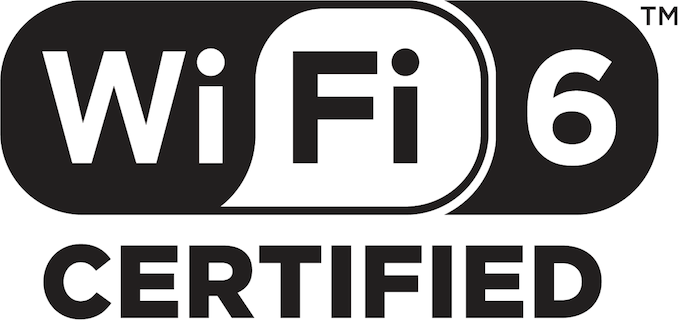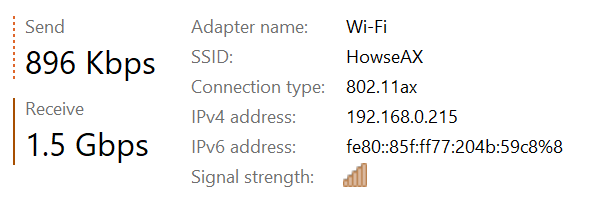AT 101: Wi-Fi 6 And Why You Want It
by Brett Howse on February 12, 2020 8:00 AM ESTTo The Future
If the question is do you need Wi-Fi 6, the answer is most assuredly “maybe”. The performance improvements are substantial, but really rely on a very strong signal to get the most data throughput. Most of the new features of Wi-Fi 6 focus on the influx of devices to the standard, and dealing with many devices connected to the same access point, or devices trying to share spectrum when connected to different access points.
The addition of Orthogonal Frequency Division Multiple Access to the Wi-Fi 6 standard will likely be the most impactful change to this revision. It will allow access points to carve up their channels into smaller slices, allowing more devices to communicate at the same time with less overhead. Each device will lose out on peak throughput, but the reduced latency should help a lot, especially in very dense environments. It should help with excessive overhead on the network layer when multiple devices are sending many small packets at once, which is a very common scenario, especially in an office or stadium situation.
Multi-User MIMO was in the Wi-Fi 5 specification as an optional implementation, and as such it did not really take off. Wi-Fi 6 should make this more prevalent, and also adds support to the MU-MIMO on the uplink, not just the downlink side. This will increase the capacity of access points for higher-speed use cases, but MU-MIMO did not get a lot of traction in Wi-Fi 5 so we will have to see how much adoption it gets in Wi-Fi 6.
The wider 160 MHz channels will offer significantly more throughput in the home environment, as we saw in our performance tests. As with the 1024-level QAM though, to see the biggest benefit you will need a strong signal. The vast majority of home networking is still limited to 1 Gigabit Ethernet, which puts Wi-Fi 6 into somewhat of an awkward spot, since it can transfer faster than most wired home networks, but even so, that is still a significant improvement over Wi-Fi 5 which would cap out around 600 Mbps on the best Wi-Fi adapters. If you work with a lot of large files, and you prefer to use Wi-Fi instead of the more consistent, yet cumbersome Ethernet, there’s still a nice boost to be had.
The future looks strong for Wi-Fi, and the Wi-Fi Alliance has made some excellent revisions to their standard to help improve Wi-Fi for the next generation of devices. As with any standards change, the impacts will not be seen right away. Both the access point, and the client need to be leveraging the new standard for the improvements to be noticeable. We’ve already seen the latest generation of smartphones start to offer Wi-Fi 6, and there’s been some movement in the PC space as well with Intel’s Project Athena. Anyone looking at a new router today should certainly opt for a Wi-Fi 6 model, but there’s likely not a major need for most people to move from Wi-Fi 5 access points right away. If you live in a heavily congested wireless area, the advantages of features like BSS coloring and Spatial Frequency Reuse should help out in those scenarios, but for people looking at purely performance, Wi-Fi 6 somewhat runs into a wall of its own making, since it can now transfer at over Gigabit speeds on a typical 2x2:2 connection. But who are we to question performance?












149 Comments
View All Comments
Mccaula718 - Wednesday, February 12, 2020 - link
Why is the WAN port only 1 Gbps?5080 - Wednesday, February 12, 2020 - link
You can always combine a WAN and LAN port into dual WAN to double the throughput. I have an ASUS RT-AX88U connected to an ARRIS SB8200 with Link Aggregation to take advantage of a 1.2Gbps internet connection.Makaveli - Wednesday, February 12, 2020 - link
Sounds like you are on a 1Gbps cable connection why bother with Link Aggregation?do you actually see the slight over provision on the connection?
deil - Wednesday, February 12, 2020 - link
at my place you can get either from 250/50 Mb/s to 1000/50 Mb/s from anyone that is quite cheap or 3000/500 from one for insane price (~20x more).I am planning for now to use that for both reliability of the uplink (I know ISP's use different nodes when they leave my place) and faster bandwidth (I have fiber to my place and cat 6 (5GB/s) internally.
5080 - Wednesday, February 12, 2020 - link
It peaks at about 1.1Gbps on LAG and 0.85Gbps on one.Dug - Wednesday, February 12, 2020 - link
1Gbs outside may actually be 1Gbs. Inside 1Gbs isn't 1Gbs because of overhead when you have multiple connections. So with aggregation you can benefit multiple connections going outside.azfacea - Thursday, February 13, 2020 - link
this is getting really ridiculous. wired lan is going from "slower" than wifi to "much slower" than wifi. If aliens came down to earth i am not sure what they would think of this lunacy.zshift - Thursday, February 13, 2020 - link
This isn't the case. 2.5Gbps and 10Gbps Ethernet has been out for a while now, it's just not propogating to consumer hardware because it isn't needed in most scenarios. Ethernet can maintain these high data rates over very long distances. This article showed that even wifi 6 across a few rooms drops to below 500Mbps. Higher wifi speeds are needed in order to compete with Ethernet over a long distance, but it's still far more stable (though not easier) to drop Ethernet throughout your place to get near 1Gbps with older routers.RadiclDreamer - Friday, February 14, 2020 - link
10gb, 25gb, 40gb and 100gb are commonplace in the business space, they just havent filtered down to consumers due to lack of demand.Keep in mind also that wifi is simplex (or half duplex) meaning that it can only send or receive but not both at the same time. You also have a lot of overhead on wifi that leads to these numbers not being as good in practice as you might think. Take a normal AC router for example, and lets say you are connected at 867mbps, thats for the entire link, not just the payload. You have WPA2 overhead, errors, retransmitted frames, interference with your neighbors/other devices, TCP/IP overhead (which is present on ethernet also) to contend with and you are going at 1/2 duplex. All of this together means that you are going to actually see about a 400mbps connection for payload.
This is not to snub wifi, its getting very good very fast. But to say that it even comes close to competing with a hardwired connection is just not understanding the technology and whats out there.
Makaveli - Friday, February 14, 2020 - link
Wifi being half duplex only applies to everything Pre Wifi 6 (AX).AX is full duplex.